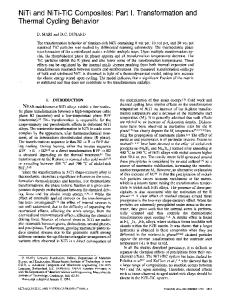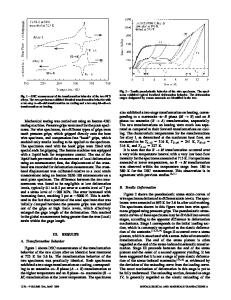Texture, strain, and phase-fraction measurements during mechanical cycling in superelastic NiTi
- PDF / 435,826 Bytes
- 10 Pages / 612 x 792 pts (letter) Page_size
- 111 Downloads / 265 Views
I. INTRODUCTION
SUPERELASTICITY is a deformation mechanism observed in NiTi and other allotropic, ordered alloys where the high-temperature cubic phase (austenite), when subjected to an external applied stress, transforms to a monoclinic phase (martensite), thus producing a macroscopic strain that augments the elastic strain. On removing the stress, the martensite is no longer stable and transforms back to austenite, resulting in a complete recovery of the macroscopic strain at the end of the mechanical cycle.[1,2] In various engineering applications,[3] superelastic alloys are subjected to repetitive loading and unloading accompanied by forward and reverse martensitic transformations of the parent austenite phase. Previous studies[4–11] have documented changes in the stress-strain response of cyclically loaded superelastic NiTi. Some of the changes previously observed with an increasing number of cycles include an increase in the residual plastic strain in the unloaded state; a decrease in the stresses at which the martensitic transformation starts and finishes; a reduction in the load-unload stress hysteresis; and a decrease in the transformation strain range. Typically, the magnitude of these changes becomes smaller as the number of cycles increases, i.e., the stress-strain curve tends toward a steady state for large numbers of cycles. While theories have been proposed in previous investigations to explain these changes, no experimental studies examined the micromechanical and microstructural changes associated with the phase transformation (e.g., volume fraction of martensite, internal strain fields, texture of the transformed martensite). Both neutron and X-ray diffraction, R. VAIDYANATHAN, formerly Postdoctoral Associate, Laboratory for Experimental and Computational Micromechanics, Massachusetts Institute of Technology, is Assistant Professor with the Advanced Materials Processing and Analysis Center (AMPAC) and the Mechanical, Materials and Aerospace Engineering Department at the University of Central Florida, Orlando, FL 32816. M.A.M. BOURKE, Technical Staff Member, is with LANSCE/MST-8, Los Alamos National Laboratory, Los Alamos, NM 87545. D.C. DUNAND, Associate Professor, is with the Department of Materials Science and Engineering, Northwestern University, Evanston, IL 60208. Manuscript submitted May 1, 2000. METALLURGICAL AND MATERIALS TRANSACTIONS A
when performed under load, can be used to study these parameters in-situ during the transformation and to obtain phase-specific information. However, neutrons penetrate deeper than X-rays (several millimeters, compared to a few micrometers for X-rays from a conventional source). Thus, neutrons are uniquely suited to study the bulk behavior of polycrystalline samples without free-surface effects. This has been demonstrated in previous publications, where the phase fraction, texture, and strain evolution of mechanically loaded superelastic NiTi were characterized by in-situ neutron diffraction during a single mechanical cycle.[12,13] In the present study, w
Data Loading...











